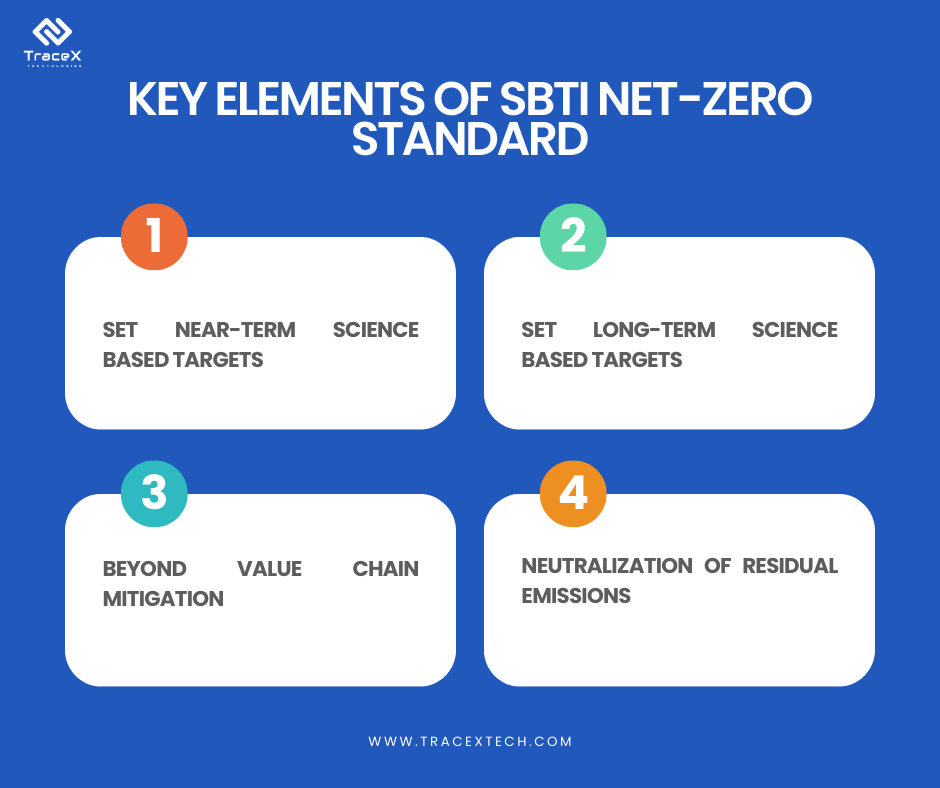Contact: +91 99725 24322 |
Menu
Menu
Quick summary: Explore the SBTi Net-Zero Standard – a vital framework for companies committed to achieving net-zero emissions. Discover its key components and how it drives climate action.

In a world confronted by the urgent challenges of climate change, organizations are increasingly recognizing the need to take bold and actionable steps towards a sustainable future. The Science Based Targets Initiative Net Zero Standard provides a comprehensive framework that empowers companies to align their strategies with the critical goal of achieving net-zero emissions.
SBTi’s standard clarifies that rapid action to halve emissions before 2030 and long-term deep emissions cuts of 90-95% before 2050 are crucial for net-zero targets to align with science.
The SBTi Net Zero Standard is not just a framework, it is a testament to the potential of collective action to reshape our future. It holds the promise of driving meaningful change and accelerating the transition to a carbon neutral world. Join us as we delve into the mechanics of the SBTi Net Zero Standard, exploring its key components, step by step process of implementation and the benefits it holds for both companies and the global fight against climate change.
The SBTi Net-Zero standard encapsulates a rigorous set of guidelines and criteria that guide organizations in their pursuit of net zero emissions. Net-Zero often regarded as the holy grail of climate action, signifies a state in which entity’s carbon emissions are completely balanced by the removal of an equivalent amount of carbon from the atmosphere. This standard provides a clear roadmap for companies to quantify their emissions, set ambitious targets and map out strategies that not only mitigate their carbon footprint but also incorporate mechanisms to offset or remove residual emissions.
SBTi is a collaborative endeavor between several organizations including the United Nations Global Compact, World Wild Fund (WWF) and the Carbon Disclosure Project (CDP) with a shared mission to empower businesses to take climate action that is grounded in scientific consensus. The initiative’s foundation rests up on the understanding that for the world to stay within the 1.5˚C threshold, as outlined in the Paris agreement, collective efforts must be driven by scientifically derived targets.
SBTi sets the stage for transformative change by assisting companies in establishing science-based targets that ensure their emission reduction efforts are in line with what climate science demands. With the introduction of SBTi standard, the initiative not only addresses emission reductions but also the critical balance achieved by offsetting emissions with measures that sequester or remove carbon from the atmosphere.
Net-Zero emissions often referred to as Net Zero is a state in which the amount of greenhouse gases emitted into the atmosphere is equal to the amount removed from it. In other words, the balance between emissions produced and emissions removed results in no net contribution to the overall greenhouse gas concentration in the atmosphere. This equilibrium is achieved through a combination of emission reductions, sustainable agriculture practices and active measures to remove carbon dioxide and other pollutants from the air. Nature- based solutions play an important role in achieving this.
A net-zero target is an aim to become carbon neutral by a certain date while the SBTi has defined what a science-based target is and coordinates their validation.
The SBTi Net-Zero Standard defines corporate net-zero as:
Reducing scope 1, 2, and 3 emissions to zero or a residual level consistent with reaching global net-zero emissions or at a sector level in eligible 1.5°C-aligned pathways
Permanently neutralizing any residual emissions at the net-zero target year and any GHG emissions released into the atmosphere thereafter.
With increasing temperatures and extreme weather events caused by increase in concentration of greenhouse gases, threats to ecosystems and biodiversity, achieving net-zero emissions is important for these reasons:
It is a commitment to a sustainable, resilient and thriving world that benefits both people and nature. The journey to net-zero requires concerted efforts, policy support, technological advancements and collective will to shape a better future.
The SBTi Net Zero standard is built on robust principles that demand clear and quantifiable commitments from participating organizations.
Organizations are required to set ambitious and science-based emission reduction targets that are in line with the limiting global warming to 1.5˚C above pre-industrial levels.
A comprehensive assessment of emissions sources is imperative considering all the three scopes of emissions, Scope 1 (direct emissions) Scope 2 (indirect emissions from energy consumption) and Scope 3 ( indirect emissions from value chain activities).
Net Zero targets must specify a clear timeline for achieving emission neutrality. This often involves interim targets and milestones to ensure continuous progress.
Organizations are encouraged to adopt strategies that prioritize emission reductions over offsetting. Sustainable carbon removal approaches and technologies are recommended where offsetting is necessary.

The SBTi Net Zero standard acknowledges the significance of all emission scopes. While many organizations focus on reducing the direst emissions (Scope 1) and indirect energy -related emissions (Scope 2), Scope 3 emissions are also essential. Scope 3 emissions constitute a substantial portion of an organizations’ overall footprint arising from activities such as supply chain processes, transportation and product use. Recognizing and addressing these emissions are integral to achieving the net-zero status.
Carbon offsetting and removal play a critical role within the SBTi Net Zero standard. While the primary goal is to minimize emissions through reduction strategies, some residual emissions are challenging to eliminate entirely. In such cases, high quality carbon offset projects or carbon removal can be employed to counterbalance the remaining emissions.
Carbon offset projects involve activities that directly or indirectly reduce emissions, such as reforestation and sustainable agriculture practices like regenerative agriculture and agroforestry, renewable energy generation and methane capture. Carbon removal on the other hand focusses on extracting carbon dioxide from the atmosphere using technologies like direct air capture.
By integrating carbon offsetting and removal in the standard, SBTi ensures that net-zero targets are both ambitious and achievable. These mechanisms provide organizations with a pathway to address emissions that are hard to eliminate while contributing to a carbon neutral future.
In embracing these key elements, the SBTi Net Zero standard empowers organizations to embark on a journey of transformative change. It guides them towards actionable strategies that align with climate science.
This standard not only propels businesses towards net zero emissions but brings a number of compelling benefits that extend across reputational, strategic and regulatory dimensions.
By aligning with the latest scientific climate goals and targets, companies validate their commitment to address climate crisis with urgency and authenticity ensuring the organization’s credibility. These standards are a set of robust scientific methodologies ensuring that the emission reduction targets are based on credible and well-founded data. By adopting this science-based approach, organizations signal that their net-zero ambitions are not mere greenwashing but a tangible step towards meaningful climate impact.
Organizations that commit to net zero emissions demonstrate leadership in environmental responsibility, aligning their actions with the value of their stakeholders. This alignment has a ripple effect on corporate reputation, enhancing the organization’s image as a purpose driven entity. Investors are more inclined to support organizations that demonstrate a commitment to long-term sustainability, minimizing climate-related risks in their portfolios.
As the global regulatory landscape evolves to address climate challenges, organizations that have already embraced the standard are ahead of the curve. They are better prepared to navigate the changing regulations, avoiding penalties and disruptions that might impact the less prepared counterparts.
As consumers become more discerning and the market shifts towards sustainability-focussed practices, organizations adhering to the standard are positioned to thrive in a changing economic landscape.
The benefits of adopting SBTi Net Zero Standard goes beyond carbon footprint reduction with organizations aligning their success with the success of the planet and laying the foundation for a sustainable and prosperous future.
The journey to achieving the SBTi Net Zero Standard is a comprehensive process that requires strategic planning, collaboration and a commitment to meaningful climate action.
Companies can take a variety of approaches to developing near-term and long-term science-based targets; however, the SBTi recommends following the five steps:
Technology plays a vital role in providing real-time visibility into emissions data. Software platforms like Trace Carbon enable organizations to track progress and make informed decisions.
The streamlined data collection through user-friendly mobile apps and integration with remote sensing and IoT devices ensures accuracy and granularity.
Trace carbon’s monitoring capabilities enable organizations to accurately measure the baselines and emissions across various scopes.
Monitoring emission reduction sin real-time gives a dashboard view of progress and keeps you in track to achieve the SBTi targets.
The data driven approach helps organizations to make informed decisions and optimize efforts on real-time information.
The robust platform simplifies the verification and reporting process and facilitates easy and transparent reporting for stakeholders.
As organizations navigate these challenges and leverage technology for emission tracking, they position themselves as leaders in the transition to a net zero future.
The adoption of SBTi Net Zero standard is not merely a commitment to environmental stewardship, it is a strategic investment in a world where responsible corporate citizenship is important. The standard provides a roadmap for your organization to thrive, ensuring that both economic prosperity and environmental sustainability go hand in hand. By integrating net zero targets with broader sustainability initiatives and fostering transparent reporting, organizations can drive meaningful change and contribute to a more sustainable and resilient world.
